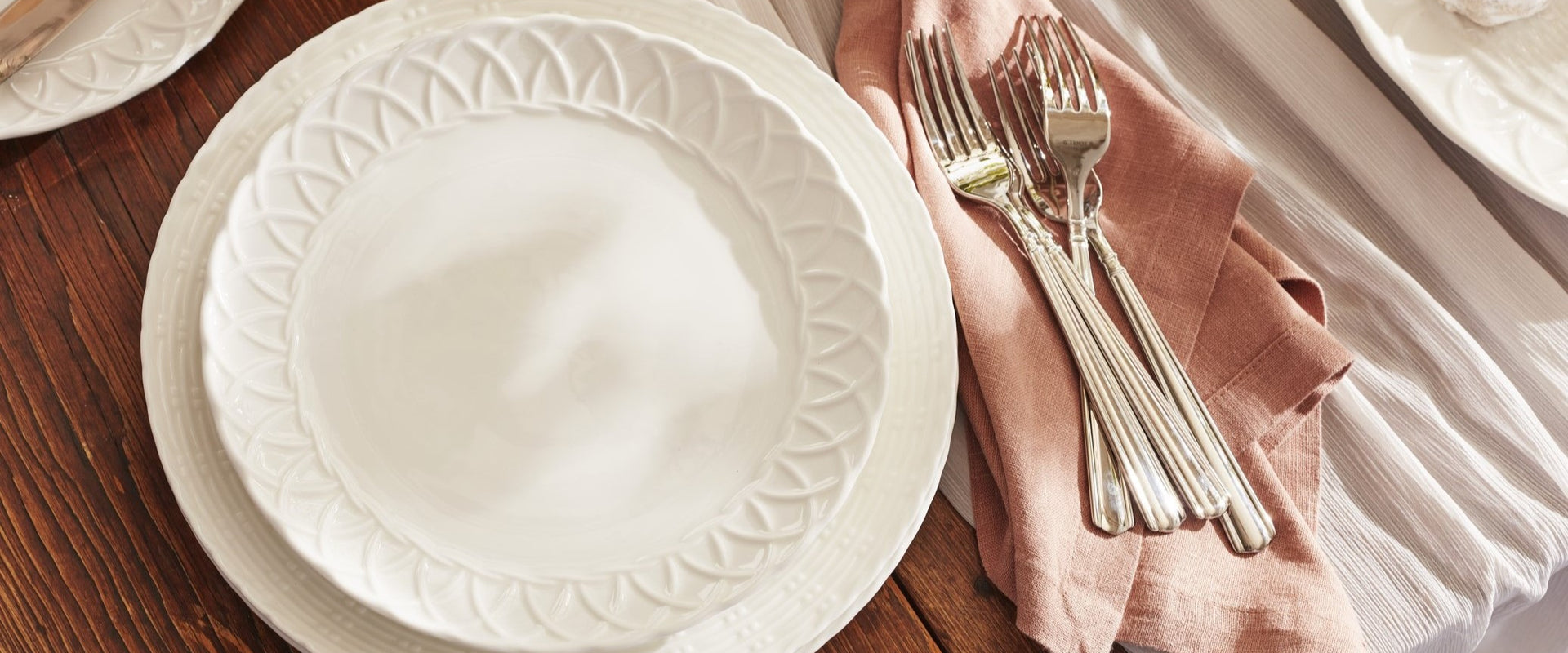
The countertops are clean, the white wine is chilling in the freezer, and in that last hour before a holiday feast or an intimate gathering with friends, our preparations usually culminate with one classic question: Should we break out the good china?
Terms like “porcelain” and “bone china” are often used interchangeably, but there are some traits that make these two fine materials distinct. So, what is bone china, and what is porcelain made of, exactly? In the simplest terms, bone china is a type of porcelain—generally more durable, with a slightly different texture and hue.
Whether you’re picking out a housewarming gift or you want to bring something beautiful to the next table you host, both porcelain and bone china are illustrious additions to any household. In this side-by-side comparison, you’ll be able to decide which material will allow you to make your next special occasion even more memorable.
What Is Porcelain?
Porcelain refers to a type of ceramic with a glassy, transparent quality when held up to the light. The material has been prized across cultures and across time for the following characteristics:
- Fine Texture – Some of the world’s oldest ceramics (known as earthenware) have a cruder appearance and texture. In contrast, products made of porcelain tend to be much finer.
- Hardiness – Porcelain is remarkably tenacious. It achieves this quality by virtue of how it’s made: porcelain is fired at very high temperatures and undergoes vitrification, a process where a substance is turned into glass. This means that, unlike cruder ceramics, porcelain is not porous (it deflects, rather than absorbs, water).
- Resonance – Europeans seldom classify porcelain based on its acoustic qualities, but this was a defining trait of the first porcelain made in China. When struck, porcelain makes a beautiful ringing sound.
Porcelain has been a coveted ceramic in Western material culture for hundreds of years, but the first porcelain was developed in China throughout the Tang dynasty.
European interest in porcelain was first kindled when trade routes opened with Eastern societies, though Europeans didn’t successfully replicate its manufacturing themselves until the late 16th century. As trade between Western and Eastern countries began to swell, Western appetites for porcelain did, too—and practices for making it began to change.
As a result, dinner tables today have inherited three main types of porcelain:
- True porcelain – Also called hard paste porcelain, true porcelain was the first to be developed. It was made from finely ground feldspathic rock, mixed with white china clay and vitrified at a temperature of 2650ºF.
- Artificial porcelain – Artificial, or soft paste porcelain, was invented by Europeans in an attempt to emulate China’s ceramics culture. It’s composed of a mixture of clay and pulverized glass, and is therefore far less durable than true or bone porcelain.
The final category of porcelain is known as bone china.
What is Bone China?
Bone china is the third and final type of porcelain. It was first developed at the turn of the 19th century and gets its name because one of its raw material constituents is bone ash (usually bovine).
The main difference between porcelain and bone china:
- Durability – While porcelain was originally known for being a strong material, it tends to chip more readily than fine bone china. Bone china was invented, in part, to remedy the frangibility of porcelain.
- Color – Unless it’s varnished with another substance, porcelain tends to carry a slight blue or gray cast. In contrast, bone china is known for its slightly more opaque, ivory sheen.
Texture – Because the materials in bone china make it so strong, it tends to be easier to manipulate without fracturing it in the manufacturing process. This enables designers to produce even thinner, delicate flatware compared with porcelain.
Choosing Between Bone China and Porcelain
Both bone china and porcelain can make for beautiful accents to any home or dinner table, as well as treasured heirlooms to pass down. Often, choosing the perfect set will come down to three main criteria: use, longevity, and price.
Use
Before choosing between bone china and porcelain, it’s important to consider how the pieces are most likely to be used. You can ask yourself:
- Will I be using my modern dinnerware sets, or are they a gift for someone else?
- Can I expect young children to be using the dinnerware?
- Will the set be displayed when it’s not in use or kept out of sight?
- How often will I realistically use my dinnerware? Will they be taken out just for special occasions, or used on a more regular basis?
Because both are highly coveted materials for ceramics, fine bone china and porcelain make exquisite gifts. You might consider purchasing them for occasions like:
- Nesting newlyweds (new couple living together)
- Milestone anniversaries
- New Year’s
- Graduations
- As a first-apartment gift
Longevity
Both bone china and porcelain are ideal ceramic materials if you want to purchase pieces you plan to keep for a lifetime (or multiple lifetimes). However, their material alone isn’t the only factor that will influence their longevity.
Before you purchase, you might want to consider:
- Storage capacity – While bone china tends to be more resilient than porcelain, how long your pieces endure will also depend on their handling when you’re not using them. So, consider how much space your household has for storage. If quarters are tight, you may want to invest in resilient bone china.
- Value – Consider what’s most important to you: the physical value of your dinnerware, or the sentimental value they’ll incur with years of use? If your dinnerware sustains a few chips in their lifetimes, will it trouble you? If yes, you may want to choose the more durable of the two (bone china). But if you’re OK with your plates being well-loved over the years, just go with the set that most appeals to your stylistic sensibilities.
Price
Deciding to purchase a high-quality dinnerware set is just one way of expressing an investment in and love for your home. Fortunately, neither bone china nor porcelain is prohibitively expensive. However, as a higher-quality material, both will inevitably come at a higher price point—at least when compared with your usual set of breakfast bowls and dishes.
Generally speaking, bone china tends to be a degree more expensive than porcelain. This is because their composition is inherently more durable, which may mean you’ll be able to pass them down for longer without incurring too much damage along the way.
How to Care for Bone China and Porcelain Dinnerware
Porcelain and bone china may have been around for hundreds (even thousands) of years. Dishwashers, on the other hand, haven’t. So, can you put porcelain in the dishwasher? What about bone china?
Fortunately, Lenox and many other manufacturers now produce dishwasher- and oven-safe dinnerware sets in both materials. Even so, there’s nothing wrong with offering a little hands-on love to your prized tableware.
Here are a few tips for taking care of your pieces:
- Avoid extreme temperatures – Extreme temperatures, whether hot or cold, can shock fine materials like bone china and porcelain, causing cracks or even fractures. Avoid storing porcelain and bone china in the freezer, and never place them in the oven.
- Use a gentle dish soap – You don’t need any special materials to clean bone china or porcelain. For both, use a mild cleaning detergent, a gentle cloth, and warm (never hot) water. Rather than let your dinnerware air dry, it’s best to sop up any remaining water with an absorbent cloth.
- Don’t be aggressive when washing – If you notice any dried food or sauces stuck to your bone china or porcelain plates, never scratch at bone china or porcelain plates with a knife, fork, spoon, or your nails. Instead, soak it in warm water and then use a microfiber cloth to gently remove the residue.
- Keep them out of the oven – While it’s produced at extremely high temperatures, porcelain and bone china can crack when temperatures change suddenly, so keep it out of the oven. However, Lenox has created microwave-safe porcelain which is also dishwasher safe!
Ideally, you’ll keep your dinnerware indoors in a safe, cool environment. Yes, just like that stately cabinet where Grandmother used to keep “the good china,” just waiting on the perfect moment to break them out for company.
Lenox: Modern Dinnerware, Timeless Materials
Every household is unique, but the first thing most of us do before a highly-anticipated gathering is set the tone with our table. It’s where we gather to surround ourselves with loved ones, reconnect, and enjoy the warmth shared between family and close friends.
Lenox has been honoring this tradition since 1889, bringing style and heart to cherished occasions with dinnerware, glassware, and the objects that make every house a home. We pride ourselves on our legacy as much as you do in your household, using quality heritage materials designed for the modern home.
From bone china and porcelain dinnerware sets for the happy couple to holiday ornaments kids will look forward to unwrapping each year, find your next treasured household staple with Lenox today.






